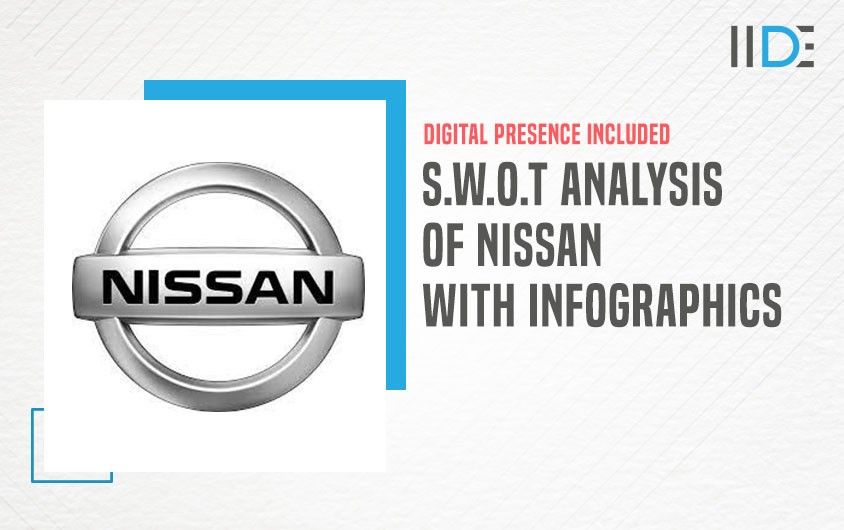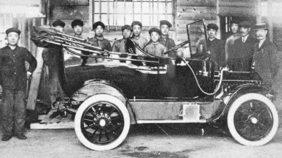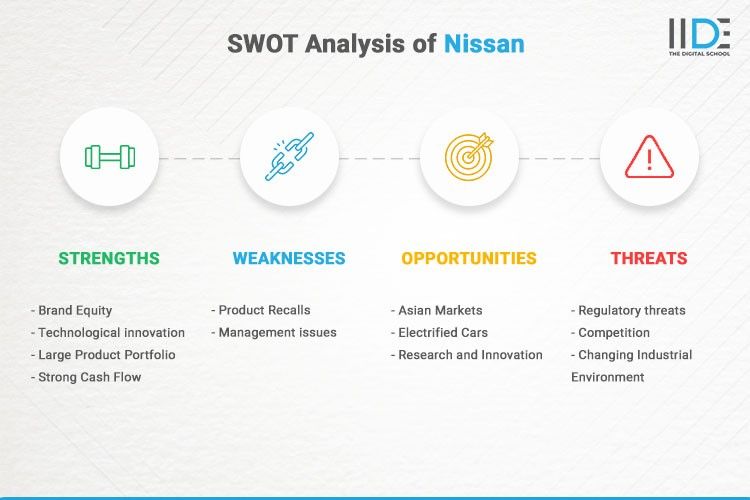Master AI automation and build AI apps live in a free online AI powerclass. Register now.
Students Centric
Placements Report
Trackable results, real numbers
Reviews
Proven success, real voices
Trainers
Expert-led, Industry-Driven Training
Life at IIDE
Vibrant Spirit student life
Alumni
Successful Journeys, Inspiring Stories
Learning Centre
Webinars
Blogs
Case studies
Live, Interactive Masterclasses
Fresh Insights, quick reads
Real-life, Industry relevant
More
Hire from us
Hire Top Digital Marketing Talent
Work with us
Join Our Team, Make an Impact
Customised Training
Personalised digital marketing training for your company
Refer & earn
Simple, easy rewards
Contact us
Get the answers you need
About us
Know more about IIDE
Explore all course options
Trending
Professional Certification in AI Strategy
- Ideal for AI Enthusiast

Updated on Dec 12, 2025
We previously looked at the SWOT Analysis Hyundai, a multinational South Korean automobile manufacturer. In this article, we will take a look at the SWOT Analysis of Nissan Company, its opponent.
Nissan Motors is a Japanese industrial firm that produces vehicles, trucks, and buses by the names Nissan and Datsun. Nissan has been committed to developing cutting-edge technology and products since its founding.
Nissan has marketed their brand to great lengths, but still have scope to tap into the digital marketing sphere. Marketing develops over time to cater to the current population’s reach and preferences. Check out our Free MasterClass on Digital Marketing 101, delivered by Karan Shah, CEO and Founder of IIDE, if you want to learn more about today’s successful digital marketing.
In this case study, we shall learn about the SWOT Analysis of Nissan Company that will give us an insight into its success. Let’s take a look at Nissan’s history, products, finance, and opponents before we get started.
About Nissan Company
Nissan Motor Company Limited is a multinational automobile manufacturing company based in Japan, launched in 1934. When founder Yoshisuke Aikawa became president of Nihon Sangyo in 1928, the name Nissan was born. Nihon Sangyo, which primarily deals with foundries and car parts, was first listed on the Tokyo Stock Exchange in 1933 under the ticker NISSAN. From there, Nissan moved beyond its Japanese roots, and in 1958, it was renamed Datsun in the United States.

Nissan’s mission and principles are to use innovation to address global environmental and socioeconomic concerns. This has always been and will continue to be at the heart of Nissan’s mission and principles. The company’s major relevance is to make a beneficial impact on people or the environment through innovation.
Nissan was in trouble by the late 1990s. It has been in cooperation with the Renault–Nissan–Mitsubishi Alliance since 1999. Nissan’s sales soared in the early twenty-first century as a result of the cooperation, fueled in part by sales of the company’s popular electric vehicles.
| Founder | Yoshisuke Aikawa, William Gorham, Rokuro Aoyama, Masujiro Hashimoto |
|---|---|
| Year Founded | 1933 |
| Origin | Yokohama, Kanagawa, Japan |
| No. of Employees | 136,134 |
| Company Type | Public |
| Market Cap | ¥2.291 Trillion (2021) |
| Annual Revenue | ¥9.878 Trillion (2020) |
| Net Profit | ¥−671.2 Billion (2020) |
Products of Nissan Company
Following are the products sold and manufactured by Nissan –
- Automobiles
- Luxury vehicles
- Commercial vehicles
- Outboard motors
- Forklift trucks
Competitors of Nissan Company
There are various brands in the motor industry. Following are top rivals of Nissan –
- Ford Motor Company
- General Motors Company
- Honda Motor Company
- Hyundai Motor Company
- Toyota Motors
Now that have understood the workings of Nissan, let’s delve into its SWOT.
SWOT Analysis of Nissan Company

Nissan Motors’ SWOT analysis examines the brand’s strengths, weaknesses, opportunities, and threats. The internal factors in the SWOT Analysis of Nissan Company include the strengths and weaknesses, while the exterior factors are opportunities and threats.
1. Strengths of Nissan Company
Strength provides the organization with a resource and a competitive advantage over other organizations. These factors are internal beneficiaries of the company. Nissan Company’s Strengths are listed below –
- Brand Equity – Within the automotive industry, brand equity is a vital strength and an indicator of business stability. Businesses invest in technology, which customers like, as well as advertising and building trusting and strong connections with stakeholders, to build strong brand equity. Nissan has maintained a strong brand fairness standard as a consequence of its continual focus on technical innovation, customer delight, and investment in employees, network, and other stakeholders.
- Technological innovation – In the automobile sector, technology innovation is the key to rapid growth. Nissan Pro-pilot, an automated driving system, is one of the company’s innovations. It is a pedal that allows for acceleration, deceleration, and complete braking with just one pedal. Nissan’s Propilot is geared for highway use and seeks to reduce the driver’s workload by providing a combination of steering, acceleration, and braking that can operate in fully autonomous mode.
- Large Product Portfolio – Nissan offers a diverse product line to meet the needs and lifestyles of various consumer segments. The company boasts a wide range of automobiles, from sedans to pickup trucks, SUVs, and sports cars. Nissan has shown to be a savvy vehicle company with a diverse product portfolio that has touched the lives of many different customer categories.
- Strong Cash Flow – Automobile sales dropped in 2018. Nissan’s net income and operating income both fell. Operating cash flow, on the other hand, is kept at a healthy level. In 2018, operating cash flow totalled 1,450.9 billion yen, up from 1,071.25 billion yen the previous year,
2. Weaknesses of Nissan Company
Customers’ reactions, as well as management difficulties, reveal an organization’s shortcomings. The weakness is frequently a limitation of the organization’s resources in comparison to its competitors, which causes the organization or corporation to perform poorly. The following are some of Nissan’s flaws –
- Product Recalls – Automobile manufacturers all around the world are juggling an overwhelming number of legal rules and laws relating to product quality and passenger safety. Nissan has also been under pressure to conduct a large number of recalls during the previous three-four years. According to Kelly Blue Book, the company recalled around three million vehicles due to airbag concerns in 2016.
- Management issues – Nissan’s problems have gotten worse after Carlos Ghosn was arrested for a financial scandal. It has brought with it a slew of issues, including internal research and reformation of the company’s shaky corporate governance structure. Carlos Ghosn was lauded as a hero in Japan before his arrest about the ocean DAL. In 1999, Nissan was on the verge of bankruptcy, and Carlos Ghosn was brought in to turn the company around. However, he was recently arrested for financial malfeasance and subsequently removed from his position as chairman.
3. Opportunities for Nissan Company
Opportunities are everything that a company can utilise for its own needs to become unique and productive in comparison to its rivals. Opportunities can be found in a variety of sectors, including changes in technology, government policy, social patterns, and so on.
- Asian Markets – Before Nissan, the Asian markets present a significant opportunity. China, in particular, which has grown to become the world’s largest car market, presents a significant possibility for sales development. Furthermore, Nissan must concentrate on building a solid local infrastructure.
- Electrified Cars – Within the last three years, the global market for electric motors has developed rapidly. Nissan also saw an increase in sales of its electrified vehicles. In comparison to the previous year, the auto industry saw a decrease in vehicle sales in 2019. Electrical motor sales, on the other hand, increased. This suggests that demand for electric motors will continue to rise in the future years.
- Research and Innovation – Making investments in current technologies and expanding the product portfolio is a great way to find growth in a difficult situation. The business is experiencing a surge in demand for electric vehicles. In such a fiercely competitive environment, where all of its rival manufacturers, particularly the American manufacturers, are investing heavily in customer delight and expanding the richness of their range via investments in research and development.
4. Threats to Nissan Company
Threats are unfavourable situations to a company’s environment. New or revised competitors, steady market expansion, faster bargaining power of major customers or suppliers, technical changes are some of the most common challenges to an enterprise’s or company’s success.
- Regulatory threats – Over the last several years, the regulatory burden on automobile manufacturers has increased dramatically. Companies are currently subjected to increased scrutiny and pressure about tool marketing efforts to avoid the first-rate consideration in 2019. Illegal constraints make it difficult to locate boom and boom market share. As a result, one of the biggest dangers is regulatory strain, followed by car compliance. on to product quality and passenger safety. Throughout the preceding few years, Nissan was forced to create a large number of recollections.
- Competition – Within the automobile industry, competition has remained fierce. Nissan’s competitors invest much in R&D, marketing, and revenue to grow their market share. These automobile manufacturers make careful expenditures to maintain their dominance in the global automobile market. In the fiscal year 2018, Nissan Motors’ net income within the global automobile business fell by 4.4 per cent compared to the previous year. It is whole automotive revenue
- Changing Industrial Environment – In 2019, the automobile industry entered a difficult phase globally. Globally, sales of electric motors have increased, while overall car income has decreased. Furthermore, customer preferences and demands for styles have evolved. In recent years, demand for SUVs and hybrids has exploded. Nissan is dealing with a wide range of internal issues. Furthermore, in comparison to its closest competitors, its R&D price range has remained significantly lower. All of this is making it difficult for the logo to expand its market share.
SWOT Analysis is a tried-and-true management tool that allows a company like Nissan Company to compare its business and performance against that of its competitors. Nissan Motors is one of the most well-known vehicle brands.


Learn Digital Marketing for FREE
- 45 Mins Masterclass
- Watch Anytime, Anywhere
- 1,00,000+ Students Enrolled


Conclusion
Nissan is a well-known Japanese automobile company. Despite decreased car sales and a smaller market share, the company maintained a good cash flow and revenue. The company’s electric car sales have soared. It was able to maintain its market share and sales in China by producing new electrical models. Its partnership with Mitsubishi and Renault has also proven fruitful. The alliance has a presence in more than 200 countries and has sold over 10 million vehicles.
When Nissan boosts their presence through various channels such as SEO, emailing, content marketing, and social media marketing, it will not only benefit from the cost-effectiveness of digital marketing, but it will also reach a wider audience than usual.
Obtaining the essential Digital Marketing abilities and completing Certified Courses may lead to possibilities to work with fashion brands such as Nissan. IIDE offers short-term certification courses in areas including social media marketing, media strategy, and more.
If you’re interested in additional in-depth company research, visit our IIDE Knowledge portal. Thank you for reading this case study on the SWOT Analysis of Nissan Company. Don’t forget to leave your feedback in the comments below.
Want to Know Why 2,50,000+ Students Trust Us?
Dive into the numbers that make us the #1 choice for career success

Courses Recommended for you
MBA - Level
Post Graduate in Digital Marketing & Strategy
Best For
Fresh Graduates
Mode of Learning
On Campus (Mumbai & Delhi)
Starts from
Mar 2, 2026
Duration
11 Months
Live & Online
Advanced Online Digital Marketing Course
Best For
Working Professionals
Mode of Learning
Online
Starts from
Jan 23, 2026
Duration
4-6 Months

Online
Professional Certification in AI Strategy
Best For
AI Enthusiasts
Mode of Learning
Online
Duration
5 Months

Offline
Undergraduate Program in Digital Business & Entrepreneurship
Best For
12th Passouts
Mode of Learning
On Campus (Mumbai)
Duration
3 Years
Recent Post
- Bosch 2025: Strategic Insights into Market Position, Challenges, and Growth Opportunities
- Nasher Miles Marketing Strategy 2025: A Journey from Trolleys to Trendsetters
- Beco Marketing Strategy 2025: Leading India’s Eco-Friendly Revolution
- P-TAL Marketing Case Study: Reviving India’s Timeless Craftsmanship
- Marketing Case Study: Rocca - Rising Above the Chocolate Crowd in India
- Unveiling What's Up Wellness Marketing Strategy: Key Tactics and Insights
- Lenskart Marketing Strategy 2025: AI, Content & Omni-Channel Success
- Ruban's Jewelry Marketing Strategy for Crafting Timeless Success in the Luxury Market
- Decoding iMumz’s Marketing Playbook: A Wellness Brand Built on Empathy
- Nish Hair Marketing Strategy: The Complete AIDA Playbook for D2C Success
Author's Note:
I’m Aditya Shastri, and this case study has been created with the support of my students from IIDE's digital marketing courses.
The practical assignments, case studies, and simulations completed by the students in these courses have been crucial in shaping the insights presented here.
If you found this case study helpful, feel free to leave a comment below.
Aditya Shastri leads the Business Development segment at IIDE and is a seasoned Content Marketing expert. With over a decade of experience, Aditya has trained more than 20,000 students and professionals in digital marketing, collaborating with prestigious institutions and corporations such as Jet Airways, Godrej Professionals, Pfizer, Mahindra Group, Publicis Worldwide, and many others. His ability to simplify complex marketing concepts, combined with his engaging teaching style, has earned him widespread admiration from students and professionals alike.
Aditya has spearheaded IIDE’s B2B growth, forging partnerships with over 40 higher education institutions across India to upskill students in digital marketing and business skills. As a visiting faculty member at top institutions like IIT Bhilai, Mithibai College, Amity University, and SRCC, he continues to influence the next generation of marketers.
Apart from his marketing expertise, Aditya is also a spiritual speaker, often traveling internationally to share insights on spirituality. His unique blend of digital marketing proficiency and spiritual wisdom makes him a highly respected figure in both fields.